

The Flipped Classroom Model: A Full Picture. Due to Khan Academy’s popularity, the idea of the flipped classroom has gained press and credibility within education circles.
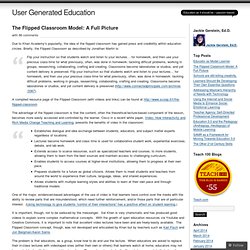
Briefly, the Flipped Classroom as described by Jonathan Martin is: Flip your instruction so that students watch and listen to your lectures… for homework, and then use your precious class-time for what previously, often, was done in homework: tackling difficult problems, working in groups, researching, collaborating, crafting and creating. Classrooms become laboratories or studios, and yet content delivery is preserved. Flip your instruction so that students watch and listen to your lectures… for homework, and then use your precious class-time for what previously, often, was done in homework: tackling difficult problems, working in groups, researching, collaborating, crafting and creating.
The Best Tools and Apps for Flipped Learning Classroom. July 25, 2014 Following the posting of "Managing iPad Videos in Schools" somebody emailed me asking about some suggestions for tools and apps to create instructional videos to use in a flipped learning setting.
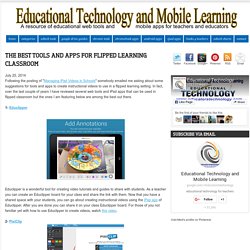
In fact, over the last couple of years I have reviewed several web tools and iPad apps that can be used in flipped classroom but the ones I am featuring below are among the best out there. 1- Educlipper Educlipper is a wonderful tool for creating video tutorials and guides to share with students. As a teacher you can create an Educlipper board for your class and share the link with them. Now that you have a shared space with your students, you can go about creating instructional videos using the iPap app of Educlipper.
Definition / Definition. How to Flip Your Classroom With eduClipper and PixiClip. Flipped learning skyrockets across the nation. Once brand new, the flipped learning model further cements its position in classrooms.
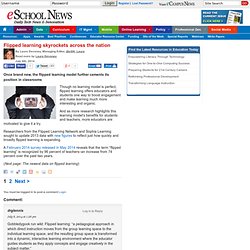
Getting Students to Watch and Engage With Flipped Videos with Crystal Kirch’s WSQ Technique. At FlipCon14 last week I learned about two good techniques to help encourage/require students to read or watch or otherwise take in and engage with learning content that you assign them in your flipped or blended classroom.
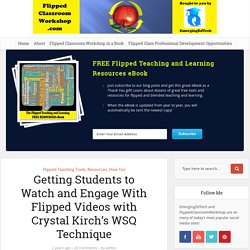
Today I share one of these and I will write about the other soon. “WSQ” (pronounced “whisk”) is a pretty simple idea, but like most ideas, the power of how it is used is in the details and application of it. Teachers can choose how to apply and leverage this as it works best in their classes, and evolve it over time to improve on it and adapt it to changing student and course needs. Study: More teachers adopt flipped instruction.
Skip to main content Browse All Briefs by Topic Study: More teachers adopt flipped instruction Forward to a friend 07/9/2014 | eSchool News (free registration)
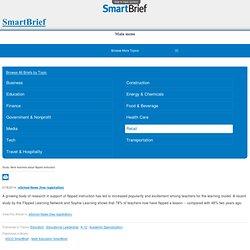
Laura Randazzo – Solutions for the Secondary Classroom. Flipping lecture content is all the rage these days and, generally, I’m a fan of the concept.
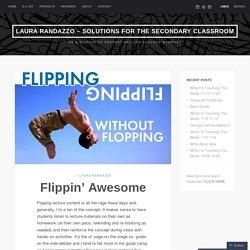
It makes sense to have students listen to lecture materials on their own as homework (at their own pace, rewinding and re-listening as needed) and then reinforce the concept during class with hands-on activities. It’s the ol’ sage-on-the-stage vs. guide-on-the-side debate and I tend to fall more in the guide camp, as I grow weary repeating the same lecture material five times a day. When I heard about flipping, I knew I could make the idea work for my high school English students. Flipped Classroom on Pinterest. Before Reading or Watching Videos, Students Should Experiment First. The researchers drew on data gathered from students using the BrainExplorer, a tabletop tool that simulates how the human brain processes visual images.

By David Plotnikoff A new study from the Stanford Graduate School of Education flips upside down the notion that students learn best by first independently reading texts or watching online videos before coming to class to engage in hands-on projects. Studying a particular lesson, the Stanford researchers showed that when the order was reversed, students’ performances improved substantially. While the study has broad implications about how best to employ interactive learning technologies, it also focuses specifically on the teaching of neuroscience and underscores the effectiveness of a new interactive tabletop learning environment, called BrainExplorer, which was developed by Stanford GSE researchers to enhance neuroscience instruction. The findings were featured in the April-June issue of IEEE Transactions on Learning Technologies.
The Flipped Classroom Model: A Full Picture. Flipped Classroom 2.0: Competency Learning With Videos. The flipped classroom model generated a lot of excitement initially, but more recently some educators — even those who were initial advocates — have expressed disillusionment with the idea of assigning students to watch instructional videos at home and work on problem solving and practice in class.
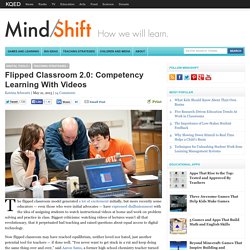
Biggest criticisms: watching videos of lectures wasn’t all that revolutionary, that it perpetuated bad teaching and raised questions about equal access to digital technology. How to Flip Your Classroom With eduClipper and PixiClip. How Flipped Classrooms Are Growing and Changing. A new survey shows the flipped classroom model is expanding and changing in K–12 classrooms, with 30 percent more teachers adopting the teaching method since 2012..
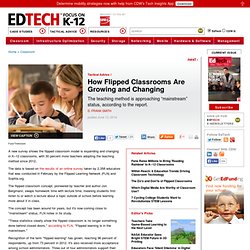
The data is based on the results of an online survey taken by 2,358 educators that was conducted in February by the Flipped Learning Network (FLN) and Sophia.org. The flipped classroom concept, pioneered by teacher and author Jon Bergmann, swaps homework time with lecture time, meaning students first listen to or watch a lecture about a topic outside of school before learning more about it in class. The concept has been around for years, but it's now coming close to "mainstream" status, FLN notes in its study.
"These statistics clearly show the flipped classroom is no longer something done behind closed doors," according to FLN. Flipped Classroom: The Full Picture for Higher Education. The Flipped Classroom, as most know, has become quite the buzz in education.
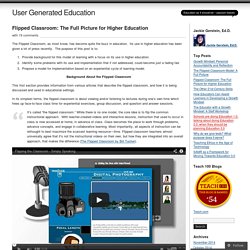
Its use in higher education has been given a lot of press recently. The purpose of this post is to: Provide background for this model of learning with a focus on its use in higher education.Identify some problems with its use and implementation that if not addressed, could become just a fading fad.Propose a model for implementation based on an experiential cycle of learning model. Background About the Flipped Classroom This first section provides information from various articles that describe the flipped classroom, and how it is being discussed and used in educational settings. Student Engagement in a Flipped Classroom. Engaging In Isolation: Student Engagement in a Flipped Classroom by Tridib Roy Chowdhury, Senior Director, Products, Adobe Systems This is part 2 of the series “Responsive Teaching For A Changing World,” a 3-part series is sponsored by Adobe Presenter 9. The Flipped Classroom model allows every student to learn at their own pace, with the rewind button of online content being used frequently as students navigate digital courses.
Combined with the own-place, own-time nature of eLearning, this means students now consume content in a very asynchronous manner. How do we know which students have completed their lesson and to what extent they have understood it? When classroom content which was previously consumed in a social context is now consumed in relative isolation at home, how do teachers get the information they need to teach effectively? 7 Stories From Educators About Teaching In The Flipped Classroom. Informed articles and commentary on this powerful and often misunderstood concept. The University of Wisconsin’s Stout School of Education publishes a great Tech Tips newsletter. The last few issues of this newsletter have been packed with resources focused on topics near and dear to us here at EmergingEdTech, and we strongly recommend signing up for this free publication.
I spent a good deal of time reading and appreciating the resources shared in a recent Tech Tips newsletter focused on the concept of “the flipped classroom”. Below I have shared several of the articles listed in the newsletter, along with a few more that I searched out, and I’ve provided a little insight into each of them. Streaming Media Products and Solutions. From the Diary of a Flipped Classroom Newbie. Like any teacher passionate about his or her subject, I LOVE working problems in physics with my students.
During my first year of teaching, class time was spent largely on concepts and examples. But only on the rare occasion did time permit ample student practice--a critical component for student success. If students make a mistake consistently, correction does not come easily without instant feedback. If questions arise while doing the work, too much time will pass before they can ask. But I quickly realized--if we were to shift basic concepts and introductory examples to outside of class, we could be discussing problems and allow for more practice time in class. So, after making a mid-year test on electrostatics for my AP Physics class, I decided from there on out that the rest of my class’s lessons were going to be flipped.
In Flipped Classrooms, Videos Require Attention - Teaching Now. Keep the lectures at home: New ‘flipped classroom’ model focuses class-time on experiments in Easthampton. EASTHAMPTON — Easthampton High School junior Kevin Van Oudenhove may not be familiar with the term “flipped classroom.” But he knows there’s something different about the honors chemistry class he’s taking this semester. For homework, Van Oudenhove’s teacher, Shawn Sheehan, asks students to watch videotaped lectures and other lesson materials posted on his website. Class time is devoted to solving equations, conducting lab experiments and working on group research projects. Van Oudenhove said he likes that much of the basic instruction for chemistry class happens outside of the classroom. “If we spent all class listening to lectures and taking down notes, we wouldn’t be able to do this,” he said, in an interview last week, gesturing towards a table where his lab partners were busy creating a reaction with baking soda and acetic acid.
The Four Pillars of Flipped Learning. May 10, 2014 In today's post I am sharing with you this excellent visual featuring the four pillars of flipped classroom, but before that here is a reminder of what flipped classroom is all about: Flipped classroom or flipped learning is a methodology, an approach to learning in which technology is employed to reverse the traditional role of classroom time. If in the past, classroom time is spent at lecturing to students , now in a flipped model, this time is utilized to encourage individualized learning and provide one-on-one help to students, and also to improve student-teacher interaction.
While the instructional or teachable content is still available in class, however this content is mainly designed in such a way to be accessed outside class which is a great way for struggling students to learn at their own pace. Flipped classrooms: Can they help students learn? Photo by Wavebreakmedia Ltd/Thinkstock This article is part of Future Tense, which is a partnership of Slate, the New America Foundation, and Arizona State University. 7 Stories From Educators About Teaching In The Flipped Classroom. The Four Steps of Flipping. 3/31/2014 By: What Is The Role Of Content In Flipped Classrooms? In a flipped classroom, students ‘attend’ the lesson outside of the classroom, typically in the form of teacher presentation videos or animated slide shows that can be viewed online, and in more sophisticated instances, followed by some diagnostic tests to indicate the progress of each student in the understanding of the material presented in that lesson.
The intent is for students to know enough of the topic (to be taught in class) and, having reflected adequately on the ideas they encountered at home, return to class with questions to clarify their understanding. The benefits of a flipped classroom are progressively recognized and relatively well-documented (Fulton, 2012; Bergmann & Sams, 2013; Bergmann 2011; Ash, 2012). Flipping The Classroom With eBooks. 5 Tips for Flipping Your PBL Classroom. I am of course a huge project-based learning (PBL) nerd and advocate. Three Questions to Consider Before We All Flip. It seems like you can't open an education periodical these days without finding an article espousing the wonders of flipping the classroom. Three Good Tools for Building Flipped Lessons That Include Assessment Tools. Resources for Flipped Classroom. After careful reflection on my predominantly direct instruction approach to teaching middle school math, I came to the realization that the majority of the students sitting in my classroom were maybe not listening to my lessons.
Why? Blogs on Flipped Classroom. Flip Your PD for Extra Flexibility & Support. How TED-ED Site Turns YouTube Videos To ‘Flipped’ Lessons. The Teacher's Guide To Flipped Classrooms. Since Jonathan Bergman and Aaron Sams first experimented with the idea in their Colorado classrooms in 2004, flipped learning has exploded onto the larger educational scene. It’s been one of the hottest topics in education for several years running and doesn’t seem to be losing steam. Basically, it all started when Bergman and Sams first came across a technology that makes it easy to record videos.
They had a lot of students that regularly missed class and saw an opportunity to make sure that missing class didn’t mean missing out on the lessons. The Flipped Classroom: 5 Ways Video Can Create Student Engagement. Introduction to Our Flipped Classroom. 5 Things I Wish I Knew When I Flipped My Class.mp4. Flipping The Classroom With FIZZ: Katie Gimbar & Dr. Lodge McCammon at TEDxNCSU. I Flip, You Flip, We All Flip: Setting Up a Flipped Classroom. Flipping Your Classroom with Google #eduonair. A Way of Flipping a Mixed Ability Class. Jan January 27, 2014 | 3 Comments “I have a mixed ability class and some of the students refuse to respond to the lessons whereas some are highly motivated and some of them join us when they feel they can do” Isn’t this a common problem for teachers? People learn better when they want to learn. I agree that teachers can only open the door, but the learners must walk through it themselves.
(Chinese proverb) However, a teacher’s task is to make every move to reach as many students as she has in the class. I love my job because it is a great way of keeping my mind active. I have a typical mixed ability class of 9th graders this year and they are forcing me to read and learn more. 5 things you should know about flipped learning. 7 Essential Tools for a Flipped Classroom - Getting Smart by Guest Author - classrooms, EdTech, flipped classroom. Is Flipped Education Worth Flipping For? How flipping saved a teacher’s career. Don’t make these mistakes with flipped learning. Top 3 FREE Ways to Capture & Create Video - AskteacherZ: Collaborative Education.
7 Stories From Educators About Teaching In The Flipped Classroom. The Flip: Why I Love It – How I Use It. The Flipped Classroom: A Student’s Perspective. Why I Gave Up Flipped Instruction. Classroom Flipping: Jump Over The Hurdles. The Biggest Hurdle to Flipping Your Class. 10 must-watch videos for flipped learning. 6 Things Teachers Do to Flip the Classroom. Flipped Classroom Training & Technologies. The Flipped Class Revealed. Flipped Classroom 2.0: Competency Learning With Videos.
A Realist's Guide: Flipping the Classroom. And the Flipped Classroom. Flipped Classroom – Real World Student Feedback. Tools and Tips for the Flipped Classroom. A Step by Step Tutorial on How to Flip your Classroom with TED Ed. Digital Learning and Grit:Tech Tools for Teachers in Flipped (and all) Classrooms. Flipped Classroom. Educational Vodcasting - Flipping the Classroom. Videos. Before We Flip Classrooms, Let's Rethink What We're Flipping To. Schools Provide Teachers with the Training Tools for Flipping the Classroom. Top Ed-Tech Trends of 2012: The Flipped Classroom. Flipped classrooms: Turning learning upside down. 'Flipped classrooms' in North Texas turn traditional teaching on its head. 3 keys to a flipped classroom.
Flipped%20Classroom%20Brief. Flipped classrooms turn learning around. Teachers: Involve parents in the flipped classroom, too. The Flipped Classroom Defined. To Flip or Not to Flip: That Is NOT the Question! » The New Doceri: Flip Your Classroom with a Flip of Your iPad Freedom to Teach. Why I Flip-Flopped on the Flipped Classroom. Can the Flipped Classroom Benefit Low-Income Students? The Flipped Class: Myths vs. Reality. How the Flipped Classroom Is Radically Transforming Learning. New Flipped vs Old Flipped. Why I Gave Up Flipped Instruction. Flipped Classrooms. Bill Nye 'The Science Guy' Talks Flipped Classrooms. Online Guides Help Teachers Flip Their Classrooms. EmergingEdTech. Education Technology. Internet and instructional technologies for teachers & other educators. Flipped Learning Network Ning - A professional learning community for teachers using screencasting in education.
What Is A Flipped Classroom? (Updated For 2012) 16 Flipped Classrooms In Action Right Now. The Flipped Classroom: Pro and Con. The Flipped Classroom: Turning the Traditional Classroom on its Head.